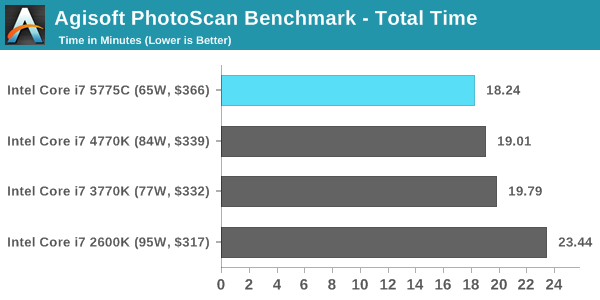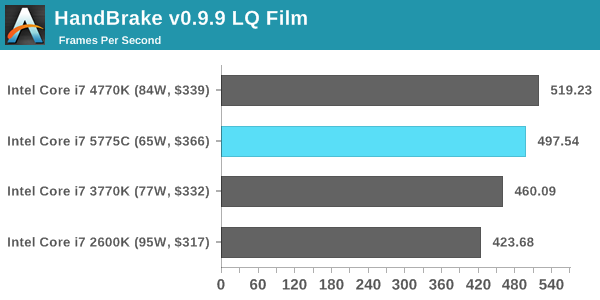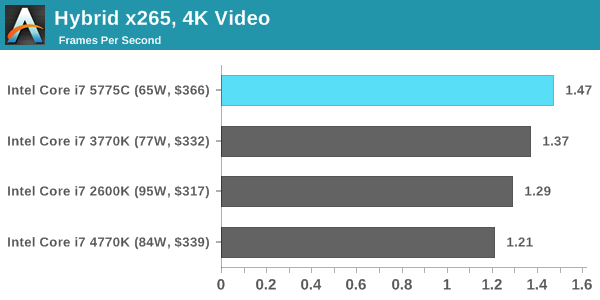The Intel Broadwell Review Part 2: Overclocking, IPC and Generational Analysis
by Ian Cutress on August 3, 2015 8:00 AM ESTProfessional Performance: Windows
Agisoft Photoscan – 2D to 3D Image Manipulation: link
Agisoft Photoscan creates 3D models from 2D images, a process which is very computationally expensive. The algorithm is split into four distinct phases, and different phases of the model reconstruction require either fast memory, fast IPC, more cores, or even OpenCL compute devices to hand. Agisoft supplied us with a special version of the software to script the process, where we take 50 images of a stately home and convert it into a medium quality model. This benchmark typically takes around 15-20 minutes on a high end PC on the CPU alone, with GPUs reducing the time.

Cinebench R15
Cinebench is a benchmark based around Cinema 4D, and is fairly well known among enthusiasts for stressing the CPU for a provided workload. Results are given as a score, where higher is better.


HandBrake v0.9.9: link
For HandBrake, we take two videos (a 2h20 640x266 DVD rip and a 10min double UHD 3840x4320 animation short) and convert them to x264 format in an MP4 container. Results are given in terms of the frames per second processed, and HandBrake uses as many threads as possible.


Hybrid x265
Hybrid is a new benchmark, where we take a 4K 1500 frame video and convert it into an x265 format without audio. Results are given in frames per second.











121 Comments
View All Comments
Pino - Monday, August 3, 2015 - link
Looks like my i7 3770 will live longer.icebox - Monday, August 3, 2015 - link
I'm really curious how the Skylake i7 will present itself in exactly this comparison article. I, like many am still on a 2600k and pondering an upgrade to either haswell-e or skylake.blaktron - Monday, August 3, 2015 - link
Me too. I run my 2600k at 4.5 ghz on air with no stability issues ever and by the looks of it, 4 years later, I'm STILL looking at a lateral upgrade. Skylake better at least add some OC headroom back along with its 15% or this might be the first gaming PC i have that dies of old age...lilmoe - Monday, August 3, 2015 - link
I'd wait it out if I were you. The 2600K is absolutely no slouch, and you'll probably be disappointed after spending lots of cash on Haswell-E. The only thing going for these newer chips are peripherals, so it's all about your priorities.HollyDOL - Monday, August 3, 2015 - link
2500k at 4.3GHz here, still no pressurre for upgrades. Not that I'd complain :-)HollyDOL - Monday, August 3, 2015 - link
pressure*where is the [edit]?
faizoff - Monday, August 3, 2015 - link
Yup same here, OC'ed my 2500K to 4.6 Ghz on air and have had the same build for over 4 years now. Still excellent performance and the only regret I have is not getting the 2600K at the time. I've started to delve greatly into developing and server VMs locally so that would've been a great setup.Kevin G - Monday, August 3, 2015 - link
I'm in a similar boot with a 2600K but I also have a Sandy Bridge-E 3930k. So far I'm not feeling any pressure to upgrade from on the processor side for either chip.For me, the most attractive thing about Skylake is the chipset which adds 20 PCIe lanes on top of the 16 from the CPU. This should enable some motherboards to stack on features without compromising dual GPU scenarios and even enable triple GPU setups with all 8x links. (There is enough lanes to do quad GPUs but DMI would be too much of a bottleneck for two cards + IO.)
Haswell-E on the other hand just doesn't interest me at all. The low end 5820K is a cheap 6 core part but has the reduced PCIe lane count. In many regards, SkyLake with Z170 would be the better option than a 5820K setup. Going to the 5930K improves IO but the price premium just isn't worth it. Thankfully Broadwell-E should be arriving at the very end of this year/early next year so hopefully Intel can revive the X99 platform.
Mr Perfect - Monday, August 3, 2015 - link
Yes, thanks for including the 2600 in this. Mine has been doing well, and with DX12 reducing CPU dependance in the future, it's probably going to be relevant for some time. It's nice to see what an upgrade will actually be worth.Sttm - Monday, August 3, 2015 - link
Heh me too. 2600k OC'd to 4.5 ghz going on over 4 years now. Which is just crazy because before that I upgraded CPU every 2 -3 years. But now it seems Intel does not care about performance, just power/performance, and AMD is a clusterduck.